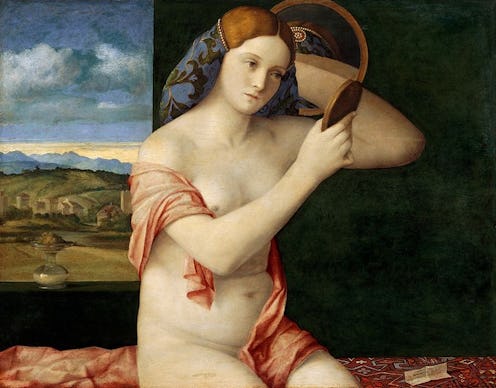Fashion
7 Gross Beauty Tips Straight From The Medieval Era

As someone who has always possessed a special interest in Medieval history, I wasn't surprised to discover that people used to follow some some pretty gross Medieval beauty tips. We're talking blood and guts and stickiness, guys. Get ready.
When someone refers to the "Medieval period" or "the Middle Ages," the time span runs approximately from the 5th to 15th century (so a long time ago). When it came to beauty, the fashion during this time was all about looking as "fair" as possible. Light skin (being "pale" represented a wealthy status and life of rich leisure, whereas a healthy "tan" would have represented someone who worked outside in the fields, and of a lower status), an even complexion (free of blemishes and things such as smallpox marks, etc.), and light-colored "blonde" hair were all traits that would lead to being considered "fair."
A lot may have changed since then (I'm very happy to be living at a time when there are so many unique forms of beauty that are celebrated), but one of the things that hasn't changed is our desire and obsession with beauty routines. Humans over the years... we just love to feel beautiful. So it's no surprise to learn that during the medieval period, people wanted to be clean, and they wanted to be beautiful, too.
Ointments, soaps, dyes, and cosmetics were extremely important beauty necessities (just like they are today) and really weren't as "Medieval" as you might think. Actually, a lot of ointments and soaps were made from plants and other natural ingredients, just like they still are today (Lush Cosmetics, anyone?). However, aside from the pretty-smelling ointments and cosmetics made from pretty-smelling plants and flowers, there were some pretty disgusting beauty tips floating around during the Middle Ages. So why don't we take a look at the seven grossest ones:
1. Cowslips And Hog Grease Ointment
It was said that in order to "add beauty" or restore beauty "once lost" (so after a rough night of getting drunk on mead and dancing too long around the hall, I'm guessing) you could prepare an ointment of cowslips (a yellow flower), hog grease, and distilled water. Yep, you read that right, hog grease. So literally the boiled fat taken from hog meat.
You know that tin can of excess cooked bacon fat/grease you keep somewhere hidden in your kitchen? Just add some water and yellow flowers to it and smear that on your face. Deliciously disgusting.
2. Blood Mask
Since having "fair" or "unblemished" skin was all the rage, one of the treatments to banish "unsightly freckles" during 14th century England was to "anoint the face with the blood of bull or hare." I'm not sure how putting something's blood on your face gets rid of freckles, but I am sure that it's pretty damn gross regardless.
Perhaps this is why Elizabeth Báthory believed that bathing in the blood of virgins would keep her young and beautiful forever?
3. For No Hair "Down There"
Whenever artwork of this time period shows naked women or female private parts at all, they're usually depicted without any body hair. Tweezing and plucking body hair was very popular back then (as it is today), so it's easy to see how women of the time may have removed the unwanted hair from their pubic regions as well.
One hair removal remedy advised women to combine red orpiment (a mineral), gum of ivy, ants' eggs, and vinegar, then rub it on the areas where you want to remove hair. Ants' eggs and vinegar all over my private parts? Don't mind if I don't, thanks.
4. Soap Of Ash And Fat
Back in Medieval times, they did have soap and things used to cleanse the body, although they weren't always very attractive products, to say the least. They might have worked OK, but they were sometimes foul-looking and foul-smelling in themselves.
Early soaps were usually made with tallow, ash, and beef or mutton fats (mmmm, ash and animal fat all over mah bodeh!), so you can get an idea of how unpleasant it probably was to bathe. I mean, you would have to have a bath after your bath to get all the ash and animal fat off you, no?!
The best soaps of the time were known as castile soap (having originated in Castile, Spain) and were made using olive oil instead of animal fats.
5. Tongue Of Hound And Lard Of Hog
Eye of newt and leg of frog! Just kidding. But not about the tongue and lard part, though. "Hound's Tongue" is actually a plant (I know, totally not as gross) and you bruise the leaves and make a juice with it. You then boil in hog's lard (more of that bacon fat they loved so much).
Now here's the gross part: You then put it in your hair. Its purpose was to help with hair loss, believe it or not.
6. Hair Of Onion
Want another helpful hair tonic? Here's a great and easy one! Just take the juice of an onion, rub it on your head, and then go lay in the sun. Mmmm, I can just smell the beauty! Personally, doing that would have me crying for multiple reasons.
7. For "Fair" Hair
So, blonde/yellow was a popular hair color to have back then, and people had different recipes to try and dye one's hair yellow. So here is the grossest (and weirdest) one: Mix honey and white wine together, apply it to your hair, and then leave it overnight. Then, add a mixture of calendine roots, olive-madder, oil of cumin seed, box shavings (what for?!), and saffron. Wash off after 24 hours.
Honey, wine, some roots and herbs, and some box shavings (for funsies?) in your hair, for 24 hours? Now that's some disgusting dedication for the sake of beauty.
Images: Wikimedia; Giphy